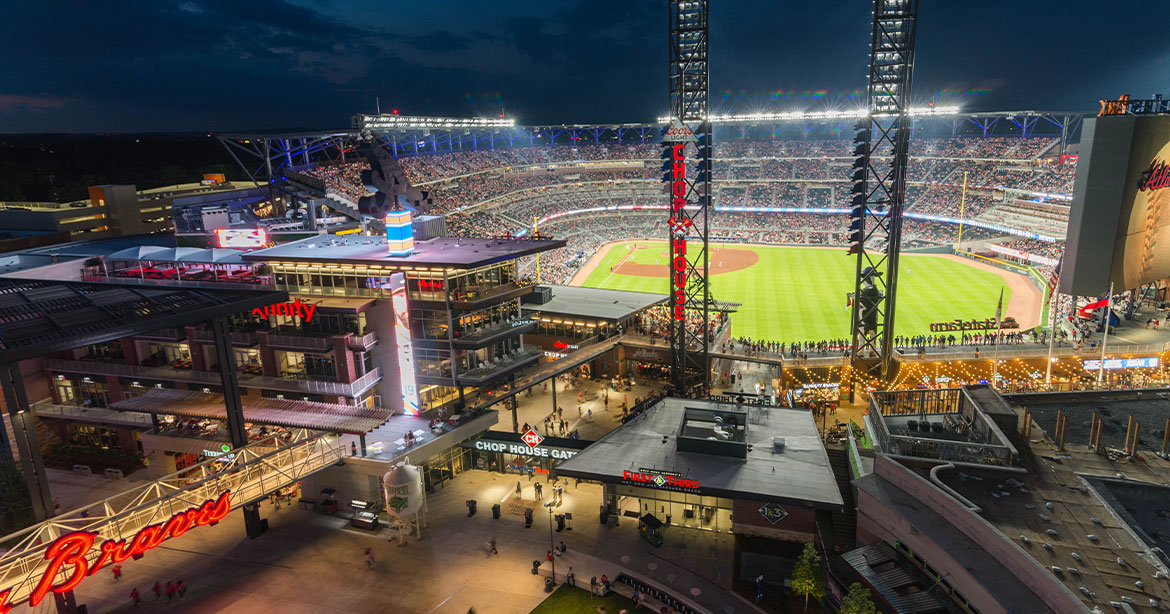
The Atlanta Braves planned to build a new sports venue after the lease for their downtown venue ended. Their stadium at the time, Turner Field, was a structure originally built for the 1996 Summer Olympics and converted into a stadium in 1997. The stadium was older and owned by the city, and the surrounding neighborhood lacked the right amenities to attract fans year-round. And with the majority of season ticketholders in northern Atlanta, Turner Field was located too far from the Braves’ fanbase.
The team wanted a newer venue with a mixed-use development to create an enhanced fan experience and appeal to patrons beyond baseball season. They needed a location close to their fanbase, and it was critical for the stadium and development to open simultaneously and in time for the April 2017 season opener.
A stadium construction project of this magnitude required precise scheduling and sequencing to deliver everything on time. As such, coordination and communication among all design and construction partners were essential to this project’s success.
Planning and Phasing a Ballpark and Adjacent Mixed-Use Development
Building a mixed-use development adjacent to Truist Park added a layer of complexity to the stadium construction project. Any material or construction delays would have triggered a domino effect that impacted the developer and contractors working on the project. Two specific key deliverables had no room for extensions or errors.
1. Moving the Atlanta Braves into Their New Office Space
The Braves needed to move out of their team offices at Turner Field and into offices at the new ballpark by January. Opening offices in the middle of an active construction zone presented numerous safety and security concerns. Extra measures would be needed to route foot traffic safely through the site while adhering to strict code requirements.
2. Completing Construction Before the Season Opener
Another even bigger challenge was ensuring both the ballpark and mixed-use development were open for the first home game in April. Most importantly, the ballpark needed to be fully functional to welcome players and fans. The Braves were also in the process of selling suites and leasing business space; they needed the surrounding development to be “storefront ready” to provide a complete experience for visitors and businesses.
Developing Solutions for On-Time Project Delivery
As part of the team American Builders 2017, Mortenson was responsible for overseeing the project sequencing, working with partners to deliver each phase on time, and communicating updates to the Braves’ ownership. Bill Hedge, project executive at Mortenson, likened the experience to coordinating an orchestra, with each partner playing an essential role in the piece. He said, “If it’s not coordinated properly, all you have is noise.”
Planning meetings became essential in coordinating schedules and navigating design changes that occurred during the early project stages. Mortenson’s team provided weekly and monthly schedule updates and worked with each of the project partners to ensure deadlines were met.
The team used BIM modeling to sequence each construction phase and provide ownership with a clear understanding of how things would look as the project progressed. Additionally, the models, paired with VR technology, helped the Braves visualize and sell club space and suites before the ballpark opened.
Prefabrication helped keep construction on schedule amid a tight timeline and worker shortages. The stadium’s brick façade was prefabricated off-site, and the team worked with contractors to prefabricate mechanical-electrical components before installation. These efforts produced significantly faster results than laying one brick at a time and installing mechanical components separately.
To open the team offices on time, Mortenson worked with code officials to open that area of the development to the public early and installed temporary barriers to keep people out of active construction areas.
"With sports construction, you don’t get extensions," says Bill. "The ball game is happening regardless. You need to be focused and proactive throughout the project, set a realistic schedule, and know the milestones you need to hit and when to hit them."
Successfully Delivering a Ballpark and Adjacent Development on Schedule
Truist Park was completed on schedule in March 2017 and is LEED Silver Certified. The project was delivered by American Builders 2017, a joint venture comprised of Brasfield & Gorrie, Mortenson Construction, Barton Malow Company, and New South Construction Company.
Truist Park and The Battery Atlanta® create the ultimate fan destination by pairing premium ballpark amenities with an experience-packed adjacent development.
Working as a unified team—owners, developers, designers, architects, contractors, subcontractors, and suppliers—made this project a success and allowed the team to welcome fans to the ballpark and adjacent development in time for the season opener.
Truist Park and The Battery set the gold standard for sports-anchored, mixed-use developments. Having the right teams in place and being strategic in planning and scheduling allowed the on-time delivery of this complex, large-scale sports construction project.


